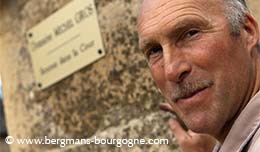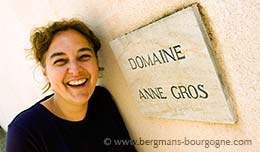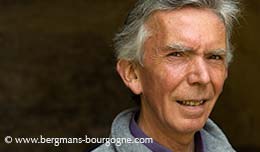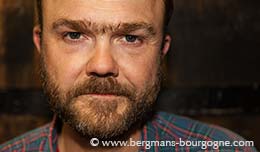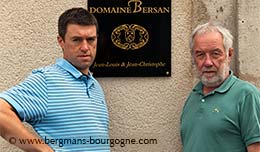
t was a now-or-never moment. Back in 2015, after twenty years with the cooperative in Lugny, Hervé Philippe decided it was time to take the plunge. This is the story about a man who saw what was missing. When nobody else was up for it he left to make the wine the clients asked for.
– I had been on the board of directors since 1995. I was 43 years old when a request for an organic cuvée came in. None of the winegrowers were able to supply it and for a cooperative like the one in Lugny you need large quantities to make a separate cuvée. So I brought some vineyards with me from the cooperative and made an organic cuvée at my place.
 Hervé Philippe sits in his living room in Champvent, a hamlet of the village of Chardonnay in the northern part of the Mâconnais. On the table in front of him is the current line-up of wines. Since his departure from the cooperative in Lugny, which is just five kilometres to the southwest, it has grown. Even if he technically runs a domaine it doesn’t say so on labels etc. He is not particularly fond of the word ”domaine”, hence it just says Hervé Philippe, vigneron.
Hervé Philippe sits in his living room in Champvent, a hamlet of the village of Chardonnay in the northern part of the Mâconnais. On the table in front of him is the current line-up of wines. Since his departure from the cooperative in Lugny, which is just five kilometres to the southwest, it has grown. Even if he technically runs a domaine it doesn’t say so on labels etc. He is not particularly fond of the word ”domaine”, hence it just says Hervé Philippe, vigneron.
 – The Mâconnais is particular since there is a cooperative every three or four kilometres. That’s the way it has been since the late 1920s. There was an economical/financial crisis and the winegrowers decided to work together. My grandfather was one of the founders of the cooperative in Chardonnay. My father never vinified a litre of wine in his whole life. All grapes were delivered to the cooperative. And then there was me. When I finished school I spent seven years at La Viti in Beaune. I wanted to set up my own business. I wanted many things. But I ended up getting involved withe the cooperative. There was this young, dynamic group on the board of directors. It was a great time. We launched new cuvées, but when it came to an organic cuvée we didn’t have the means.
– The Mâconnais is particular since there is a cooperative every three or four kilometres. That’s the way it has been since the late 1920s. There was an economical/financial crisis and the winegrowers decided to work together. My grandfather was one of the founders of the cooperative in Chardonnay. My father never vinified a litre of wine in his whole life. All grapes were delivered to the cooperative. And then there was me. When I finished school I spent seven years at La Viti in Beaune. I wanted to set up my own business. I wanted many things. But I ended up getting involved withe the cooperative. There was this young, dynamic group on the board of directors. It was a great time. We launched new cuvées, but when it came to an organic cuvée we didn’t have the means.
Since 2015 the number of wines Hervé Philippe makes has grown. The current line-up includes four whites and a red, all from around the village. Three quarters of what his vineyards produce are sold off as either grapes or must, mainly to winemaking friends who have a négociant business set up as an addition to their domaine. Julien Guillot in Cruzille and Jean-Marie Chaland in Viré are among those who receive deliveries from Hervé Philippe.
 – All my vineyards are around here. At the most one kilometre from here. And all are in the commune of Chardonnay. I don’t have any Mâcon-Villages. All is Mâcon-Chardonnay. So yes, I make chardonnay in Chardonnay.
– All my vineyards are around here. At the most one kilometre from here. And all are in the commune of Chardonnay. I don’t have any Mâcon-Villages. All is Mâcon-Chardonnay. So yes, I make chardonnay in Chardonnay.
Chardonnay is one of the 26 communes in the Mâconnais which may add its name to Mâcon on the labels. In this case the mention of Chardonnay on the label is purely a geographical descriptor, even if the bottle contents are 100 per cent chardonnay.
One of the Mâcon-Chardonnay cuvées – Terres de Champvent – is a blend of four parcels. The other three – Les Perrières, Les Chézeaux and La Pugette – are vineyard-specific bottlings.
 – The Terres de Champvent is the entry-level wine of the four, says Hervé Philippe. It’s a bit saline. Les Chézeaux is really on clay and limestone, but on blue marl. It’s a very mineral wine. Crisp and tight. La Pugette is white limestone, chalk. High up, very sunny. It’s a very floral wine. It’s much warmer there.
– The Terres de Champvent is the entry-level wine of the four, says Hervé Philippe. It’s a bit saline. Les Chézeaux is really on clay and limestone, but on blue marl. It’s a very mineral wine. Crisp and tight. La Pugette is white limestone, chalk. High up, very sunny. It’s a very floral wine. It’s much warmer there.
– Les Perrières is my oldest vineyard. It’s a small parcel of 11 ares planted in 1963. It’s just opposite of La Pugette. It’s just a road that separates them. The soil is a bit deeper than in La Pugette. This is the only parcel I vinify in oak. The other three are in tank, metal tanks with enamel. I make three barrels of this wine.
 – The pinot noir – the Bourgogne rouge, Bois Rue – is also vinified in barrels. The pinot noir is also on clay and limestone, but there are also small stones very rich in iron. Perfect for the pinot.
– The pinot noir – the Bourgogne rouge, Bois Rue – is also vinified in barrels. The pinot noir is also on clay and limestone, but there are also small stones very rich in iron. Perfect for the pinot.
Hervé Philippe prefers to keep his wine at least ten to twelve months after bottling before they hit the market. He uses very little sulphur and because of that the wines require more time to come together.
– I have four hectares here, he says. With the part which is still with the cooperative I have twelve and half hectares. All is farmed organically.
– Over the past ten years more and more set up their own business around here. The children to the growers working with the cooperative want to do their own thing. The cooperative doesn’t pay very well.
The vineyards are harvested more or less at the same time. Over three days all grapes are brought in to the winery, Barrels are used for two wines, but in terms of vinification all wines are treated the same.
 – In the vineyards I’m 100 per cent organic. I plough. I rarely leave grass between the rows. I keep it as simple as possible.
– In the vineyards I’m 100 per cent organic. I plough. I rarely leave grass between the rows. I keep it as simple as possible.
– Every year you’ll find the same character in each of the wines. Each parcel has its own character. The differences you taste are down to the terroir.
Champvent only has 60 inhabitants. Hervé Philippe’s father was born here. He still lives just across the street.
– It’s very small, says Hervé Philippe. But there are many things to do here. We even have a theatre. I have always been into theatre, ever since I was eight years old. There is a semiprofessional troupe at the theatre here. I was part of it 1996-1998. We were a small group, a cafe theatre kind of thing. We toured the whole of France and did 140 shows over two years. It was great fun. Julien Guillot (Domaine des Vignes du Maynes) used to be a part of it too. I stopped when I got my own vineyards to take care of. I couldn’t do both and I had to choose the one where I earned a little bit more money.
© 2022 Ola Bergman










